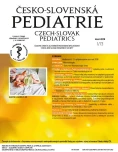Neonatal pneumothorax – incidence and risk factors
Authors:
Z. Uhríková 1; D. Murgaš 2; K. Maťašová 1; M. Zibolen 1
Authors‘ workplace:
Neonatologická klinika, Jesseniova lekárska fakulta v Martine, Univerzita Komenského v Bratislave, Univerzitná nemocnica Martin
1; Klinika detskej chirurgie, Jesseniova lekárska fakulta v Martine, Univerzita Komenského v Bratislave, Univerzitná nemocnica Martin
2
Published in:
Čes-slov Pediat 2018; 73 (1): 23-30.
Category:
Overview
Objective:
Neonatal pneumothorax occurs as a common complication of underlying pulmonary disease or/and ventilatory support. Pneumothorax can also develop at the onset of respiration. The aim of the study was to establish rate, risk factors and outcome of neonates with pneumothorax hospitalized in Neonatal Intensive Care Unit of University Hospital Martin.
Methods:
Retrospective analysis was used to evaluate newborns admitted to Neonatal Intensive Care Unit University Hospital Martin from January 2010 to March 2017. Model of logistic regression was used for prediction of pneumothorax according to common risk factors in neonates divided according to gestation age in tree groups. Using logistic regression, we analyzed the relationship between the onset of pneumothorax and increased mortality, the incidence of bronchopulmonary dysplasia and intraventricular bleeding.
Results:
The study included 1962 newborns of which 421 (21.4%) were born <32 weeks GA, 824 (41.9%) were born in 32–36 weeks GA. and 717 (36.5%) were born in ≥37 weeks GA. The overall incidence of pneumothorax over follow up period was 3.0%, with the highest incidence of pneumothorax in the group of extremely and immature neonates 4.7%. Statistically significant risk factors were in the neonate group <32 week GA use of surfactant and artificial pulmonary ventilation as a form of initial ventilatory support, in 32–36 week GA diagnosed pulmonary pathology, early infection, surfactant administration and artificial lung ventilation, for newborns born ≥37 weeks GA use CPAP. In all three groups, the risk factor was birth outside the perinatal center. In early preterm neonates the pneumothorax was associated with increased mortality without affecting the incidence of bronchopulmonary dysplasia and intraventricular bleeding.
Conclusion:
The highest incidence of pneumothorax was observed in early preterm neonates. The identified statistically significant risk factors were almost similar for each gestational week. The identified risk factors were almost identical for each age group.
Key words:
newborn, pneumothorax, risk factors
Sources
1. Santos SÍ, Flôr-de-Lima F, Rocha G, et al. Pneumothorax in neonates: a level III Neonatal Intensive Care Unit experience. J Pediatr Neonat Individual Med 2016; 5 (2): e050220.
2. Melinda M. Pulmonary air leak. In: Hansen AR, et al. Manual of Neonatal Care. 8th ed. Philadelphia: Lippincott Williams & Wilkins (LWW), 2016: loc 11035.
3. Hany A, An M, Ceyda A, Maide O. Pneumothorax in the newborn: clinical presentation, risk factors and outcomes. J Matern Fetal Neonatal Med 2014; 27 (4): 402–440.
4. Hassan M, Begum M, Jahan N, et al. Pneumothorax in neonate. North Int Med College J 2014; 5 (2): 357–359.
5. Sweet DG, Carnielli V, Gresien G, et al. European Consensus Guidelines on the Management of Respiratory distress syndrome – 2016 Update. Neonatology 2017; 111 (2): 107–125.
6. Aldana-Aguirre JC, Pinto M, Featherstone RM, et al. Less invasive surfactant administration versus intubation for surfactant delivery in preterm infants with respiratory distress syndrome: a systematic review and meta-analysis. Arch Dis Child Fetal Neonatal Ed 2017; 102: F17–F23.
7. Hines D, Modi N, Lee SK, et al. Scoping review shows wide variation in the definitions of bronchopulmonary dysplasia in preterm infants and calls for a consensus. Acta Paediatr 2017; 106 (3): 366–374.
8. Volpe JJ. Intracranial hemorrhage: Germinal matrix-intraventricular hemorrhage. In: Neurology of the Newborn. 5th ed. Philadelphia (PA): Saunders Elsevier, 2008: 517–588.
9. Duong H, Mirea L, et al. Pneumothorax in neonates: Trends, predictors and outcomes. J Neonat Perinat Med 2014; 7: 29–38.
10. Australian and New Zealand Neonatal Network. Report of the Australian and New Zealand NeonatalNetwork2007[Internet]. http://www.npsu.unsw.edu.au/sites/default/files/npesu/datacollection/Report%20of%20the%20Australian%20and%20.
11. Horbar JD, Badger GJ, Carpenter JH, et al. Trends in mortality and morbidity for very low birth weight infants, 1991–1999. Pediatrics 2002; 110: 143–151.
12. Hayes B, Mirosh M, Payton N, Sankaran K. Risk factors associated with respiratory distress in term neonates with and without air leak: A case controlled quality assurance study. Poster presented at: Montreal CPS Meeting; 2004 Jun 26–30; Montreal, Canada.
13. Boo NY, Cheah IG. Risk factors associated with pneumothorax in Malaysian neonatal intensive care units. J Paediatr Child Health 2011; 47: 183–190.
14. Esme H, Dogru O, Eren S, et al. The factors affecting persistent pneumothorax and mortality in neonatal pneumothorax. Turk J Pediatr 2008; 50: 242–246.
15. Javorka K, et al. Lekárska fyziológia. 2. vyd. Martin: Osveta, 2006: 1–678.
16. Soll R, Ozek E. Multiple versus single doses of exogenous surfactant for the prevention or treatment of neonatal respiratory distress syndrome.Cochrane Database Syst Rev 2009 Jan 21; (1): CD000141.
17. Janota J, Straňák Z. Neonatologie. 1. vyd. Praha: Mladá fronta, 2013: 1–363.
18. Clevenger L, Britton JR. Delivery room continuous positive airway pressure and early pneumothorax in term newborn infants. J Neonatal Perinatal Med 2017; 10 (2): 157–161.
19. Mehrabanri D, Gowen CW, Kopelman AE. Association of pneumothorax and hypotension with intraventricular hemorrhage. Arch Dis Child 1991; 66: 48–61.
20. Maťašová K. Neonatologia I. Bratislava: Univerzita Komenského, 2010: 1–155.
21. Smolarová S, Kocvarova L, Matasová K, et al. Impact of Updated Neonatal Consensus Guidelines on the Management of Neonatal respiratory distress syndrome on clinical outcome of preterm infants. Advs Exp Medicine, Biology – Neuroscience and Respiration 2015; 4: 61–66.
Labels
Neonatology Paediatrics General practitioner for children and adolescentsArticle was published in
Czech-Slovak Pediatrics

2018 Issue 1
Most read in this issue
- What disease can be hidden behind a diagnosis of erythema nodosum
- Neonatal pneumothorax – incidence and risk factors
- Neonatal outcomes of extremely preterm newborns in Czech Neonatal Network
- Measles in childhood – experience from the outbreak in Ostrava region in 2017
